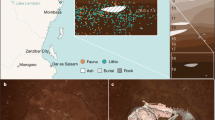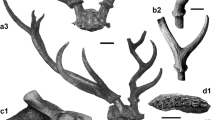Abstract
Close examination of three early hominid crania from Africa yields taphonomic information long after they were excavated, and can contribute information relevant to their dating and taxonomic status. The condition of the bone and breaks and markings are reviewed in the Florisbad, Saldanha and Broken Hill (Kabwe) crania, indicating animal biting while the bone was still fresh in the first and last of these specimens. However, the damage to the base of the Kabwe cranium indicates that there may also have been breakage by hominids, including scorings near the margin of the squamous suture. No tooth marks are observed on the Saldanha cranium, but a depressed fracture and other lesions indicate hominid damage to fresh bone. Postmortem weathering indicates cranial thickness even greater than the original measurements, which implies a more primitive evolutionary status for Saldanha than for Kabwe. This view is supported by other morphological evidence, and suggests a considerably earlier date for Saldanha and a classification asHomo erectus.
Résumé
L'examen à fond de trois crânes d'hominidés anciens de l'Afrique fournit des données taphonomiques longtemps après la fouille, et peut livrer informations quant à leur date et à leur statut taxonomique. L'état de l'os et les cassures et d'autres traces sont étudiés dans les crânes de Florisbad, Saldanha et Broken Hill (Kabwe); dans ceux de Florisbad et de Broken Hill on constate que l'os a été mordu par des animaux lorsqu'il était encore frais. Cependant les dégâts à la base du crâne de Kabwe—y compris des stries près du bord de la suture squameuse—indiquent qu'il peut aussi avoir été cassé par des hominidés.
Il n'y a pas de traces de morsures sur le crâne de Saldanha, mais on y observe une fracture aplatie et d'autres lésions qui indiquent que l'os frais a été endommagé par des hominidés. A cause des altérations survenues après la mort, on constate que le crâne original était même plus épais que les premières mésures l'indiquaient, ce qui implique un statut évolutionnaire plus primitif pour Saldanha que pour Kabwe. Cette idée, renforcée par d'autres indices morphologiques, suggère que Saldanha est beaucoup plus ancien que l'on ne croyait, et doit être classifié commeHomo erectus.
Similar content being viewed by others
References
Behrensmeyer, A. K. 1978. Taphonomic and ecologic information from bone weathering.Paleobiology 4:150–62.
Butzer, K. W. 1973. Re-evaluation of the geology of the Elandsfontein (Hopefield) site, South-western Cape, South Africa.South African Journal of Science 69:234–8.
Clark, J. D. 1959. Further excavations at Broken Hill, Northern Rhodesia.Journal of the Royal Anthropological Institute 89:201–31.
Clarke, R. J. 1985. A new reconstruction of the Florisbad cranium, with notes on the site. InAncestors: the hard evidence (ed. E. Delson): pp. 301–5. New York: Alan R. Liss.
Delson, E. (ed). 1985,Ancestors: the hard evidence. New York: Alan R. Liss.
Dreyer, T. F. 1935. A human skull from Florisbad, Orange Free State, with a note on the endocranial cast by C. U. Ariens Kappers.Koninklijke Akademie van Wetenschappen te Amsterdam, Proceedings 1: 65–77.
Klein, R. G. 1973. Geological antiquity of Rhodesian man.Nature 244:311–12.
Mollison, T. 1937. Die Verletzungen am Schädel und den Gliedmassenknochen des Rhodesiafundes.Anthropologischer Anzeiger 14:229–34.
Singer, R. 1954. The Saldanha skull from Hopefield, South Africa.American Journal of Physical Anthropology 12:345–62.
Singer, R. 1958. The Rhodesian, Florisbad and Saldanha skulls. InHundert Jahre Neanderthaler (ed. G. H. R. von Koenigswald): pp. 52–62. Utrecht: Kemink en Zoon.
Tappen, N. C. 1978. The vermiculate surface pattern of brow ridges in Neandertal and modern crania.American Journal of Physical Anthropology 49:1–10.
Tappen, N. C. 1979. Studies on the condition and structure of bone of the Saldanha cranium.American Journal of Physical Anthropology 50:591–604.
Weidenreich, F. 1943. The skull ofSinanthropus pekinensis.Paleontologica Sinica, New Series D, 10:1–291.
Yearsley, M. 1928. The pathology of the left temporal bone of the Rhodesian skull. InRhodesian Man and Associated Remains (eds. W. P. Pycraftet al.): pp. 59–63. London: British Museum (Natural History).
Rights and permissions
About this article
Cite this article
Tappen, N.G. Circum-mortem damage to some ancient African hominid crania: a taphonomic and evolutionary essay. Afr Archaeol Rev 5, 39–47 (1987). https://doi.org/10.1007/BF01117081
Issue Date:
DOI: https://doi.org/10.1007/BF01117081




